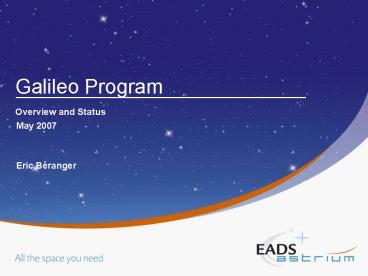Galileo Program - PowerPoint PPT Presentation
1 / 9
Title: Galileo Program
1
Galileo Program
- Overview and Status
May 2007 Eric Béranger
2
History political context of the Galileo program
- Worldwide situation today
- Satellite navigation is dominated by the Global
Positioning System (GPS, USA) and to a lesser
extent by the GLobal Orbiting NAvigation
Satellite System (GLONASS, Russia) - Both available systems are under military control
and built predominantly to military
specifications, civilian use is not
commercialised with an absence of service
guarantee and liability regime - China, Japan and India are also seeking to
develop their own GNSS - A European vision
- The European Commission (EC) has decided in 1998,
to develop its own (civil) system, in close
cooperation with the European Space Agency (ESA),
- Galileo is one of Europes most strategic and
ambitious project in political, economical,
technical and social dimensions
Galileo aims at providing a global satellite
navigation service for civilian and
governmental purposes under EU control
3
Geopolitical impacts of Galileo
- European countries participation
- EC 27 Member States in charge of funding
- ESA 17 Member States (and in charge of
development) - Non-European partners
- U.S. agreement concluded, GPS and Galileo will
be interoperable, US will supply roughly 20 of
Galileo components - China GJU-National Remote Sensing Centre of
China (NRSCC) agreement signed (19/09/03),
potential involvement in the GSA - Israel GJU-Israeli Industry Centre for RD
(MATIMOP) agreement signed (13/07/04) - Cooperation agreement signed with Ukraine
(1/12/05), South Korea (January 2006) and Morocco
(December 2006) and initialled with India. - Discussion under way with Argentina, Norway,
Switzerland, Canada, Australia, Brazil and Saudi
Arabia.
Beyond Europe, Galileo will have a strong world
wide impact on security transport
Participation of third countries is catalyst for
further co-operation.
source europa.eu, Memo/06/471, 8th December 2006
4
Galileo System Technical Principle
- Satellite navigation pinpoints a location by
measuring the distances to at least four known
locations- the Galileo satellites- using small
receivers - Galileo will be composed of three distinct
segments and complemented by EGNOS
As the precursor to Galileo, EGNOS will provide
beneficial experience and will help market
development
5
Comparison with existing systems
SatNav Systems Galileo GPS GLONASS
Satellite
Operational capability 2011 1994 (GPS III planned for 2012) 1995
Constellation 30 satellites 27 satellites 24 satellites
Horizontal Accuracy 4 m (SoL DF) lt 13 m 57-70 m
Vertical Accuracy 8 m (SoL DF) lt 22 m lt70 m
Availability 99.5 94 (Russia)
Integrity Risk lt 2x10-7 / 150sec NA NA
Time To Alert 6sec
Continuity Risk lt 8x10-6 / 15sec
- Galileo targets significant benefits to end
users, in particular - Improved positioning accuracy
- Enhanced availability of navigation signals (more
satellites, more signals) - System integrity features, i.e. the ability of
the system to supply information on the
dependability of the navigation information
distributed
6
Galileo services
Free of charge, no integrity information, no service guarantee
2 additional signals, payment of a fee
This service has to be certified by applying organisations (e.g. EuroControl for aviation)
Under European governmental control, available in times of crisis, accessible to authorised governmental users only
global reception and handling of distress messages
Through its 5 services, Galileo is envisaged to
serve both civil and governmental applications,
bridging the gap between public safety, civil
security and military markets
7
Galileo Applications
Main Market Segments
Related Applications
Service
Location Based Services
Information navigation services, Emergency
Assistance, mobile payments
OS
Route guidance, fleet management, real-time
traffic information, electronic charging,
emergency calls,
Road
OS / CS
Train signaling, traffic and asset management,
track construction survey, passenger comfort
Rail
OS / CS
Ocean inland navigation, vessel traffic mgt,
harbour operations, search rescue operations,
Maritime
OS / CS
Precision agriculture, oil gas exploration,
fisheries, telecom network synchronization, bank
insurance
Professional
OS / CS
Assistance to ground operations, take-off,
en-route flying and precision approach for
increased safety
Aviation
SoL
Law enforcement, boarder control, peace keeping,
surveillance, emergency operations
Security
PRS
8
Phases of the Galileo Program
Phase Objective
Definition Basic specifications ? Galileo Mission Requirements Document
Development (GSTB) Validation (IOV) Validation of the system design through the Test-Bed phase (2 satellites) followed by In Orbit Validation (4 satellites associated ground stations)
Deployment (FOC) Full deployment of the remaining 26 satellites and the ground infrastructure
Operations Operational service provided by a private concessionaire for 20 years
2032
2008/9
2012
2003
1999
TIMELINE
DEVELOPMENT IN-ORBIT VALIDATION (IOV) - 1.5bn
DEPLOYMENT 3.4 bn
OPERATIONS 220m/year
DEFINITION 100m
Concessionaire (PPP)
EC/ESA
Galileo Joint Undertaking / GSA
ESA
Timeline and risks need to be carefully
managed. Considering the GPS modernisation, a
delayed operability would be detrimental to
Galileos success in the international market for
satellite navigation.
9
Current Status Next Steps
- Major achievements of the program
- GIOVE-A was launched from the Baïkonur cosmodrome
on 28 December 2005 - 05/12/2005 Agreement on the location of
companies, centres and facilities - Nov/2006 Signature of the Shareholder agreement
by the 8 members of the Merged Consortium - 29/11/2006 Agreement on the core elements of the
concession contract (Heads of Terms) - 01/01/2007 The GNSS Supervisory Authority (GSA)
took over from the Galileo Joint Undertaking
(GJU) - 28/03/2007 Incorporation of EURO GNSS SAS in
Toulouse (former Galileo Operating Company) - Failure in the Concession Contract Negotiations
- Difficulties to find an agreement on risk sharing
between Public and Private sector - Unclear roles and responsibilities distribution
in public governance - Technological complexity underestimated
- Retained Scenario
- Immediate implementation of EGNOS through a
specific concession - 2008- 2012 Public sector will endorse the
continuation of the Galileo project until FOC - 2010-2030 PPP for the procurement of remaining
satellites, if any, and the exploitation,
operations and maintenance of the infrastructure - Changes to avoid any other failure































